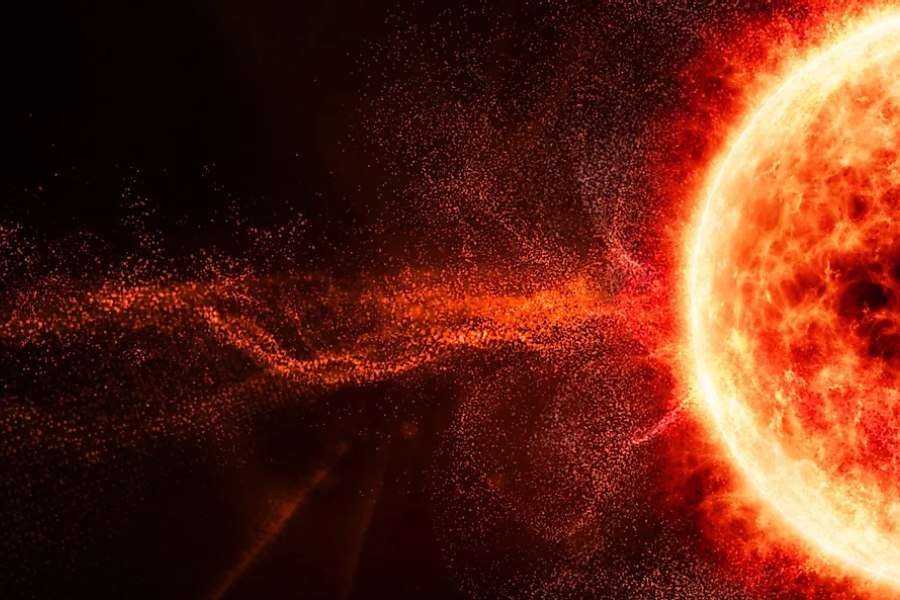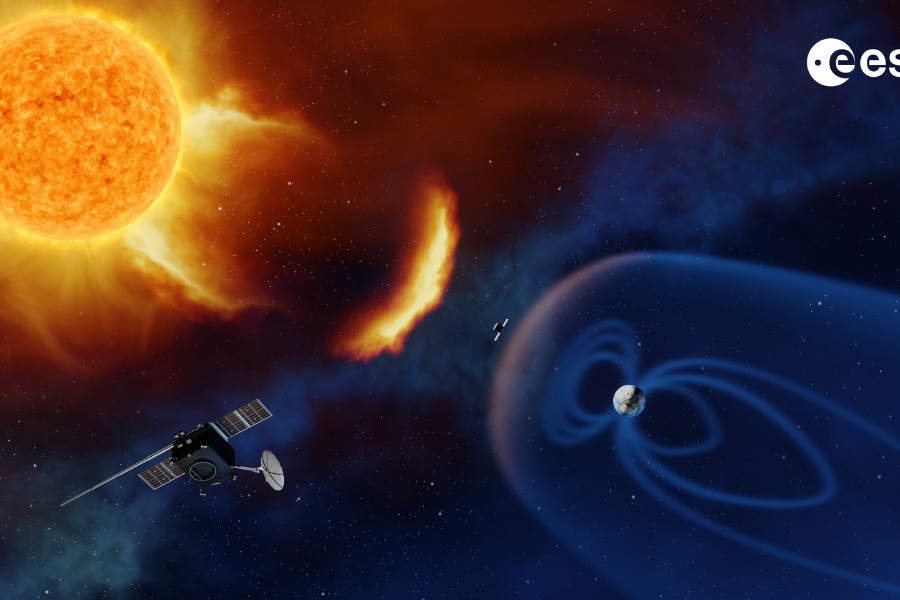In the expanse of the cosmos, imagine a continuous flow of tiny charged particles zooming away from the Sun in all directions. These speedy particles, called solar winds, create an invisible breeze that shapes the space around us. It’s like a cosmic windstorm blowing through the universe. But how fast are solar winds?
Join us as we venture into the vastness of space to uncover the secrets of solar winds. We’ll dive deep into their origins, how they work, and what they mean for our understanding of the universe.
Get ready to be amazed because the world of solar winds is where the ordinary transforms into the extraordinary and where the rules of physics take on a whole new dimension. Together, let’s embark on this journey of discovery, immersing ourselves in one of nature’s most incredible phenomena.

How Fast Are Solar Winds?
The speed of solar winds can vary widely, but on average, they have speeds ranging from 300 to 800 kilometers per second (about 186 to 500 miles per second).
However, solar wind speeds can temporarily spike to much higher values during periods of increased solar activity. For example, it can be as solar flares or coronal mass ejections (CMEs).
The continuous flow of solar wind plays a significant role in shaping the heliosphere and influencing the space environment around the Sun. That includes the interaction with Earth’s magnetosphere.
Typical Solar Wind Speeds and Variations
The average speed of solar winds
Solar winds typically travel at an average speed of about 400 kilometers per second or 1 million miles per hour. This is approximately 0.13% the speed of light. But this is just an average value, and the actual speed of solar winds can vary significantly.
The speed of solar winds is not uniform across the Solar System. As the wind moves away from the Sun, it gradually slows down due to the Sun’s gravitational pull and the pressure of the interstellar medium.
By the time solar winds reach Earth, which is about 150 million kilometers from the sun, their average speed drops to around 350 kilometers per second (approximately 217 miles per second). So, how fast do solar winds travel near Earth? The answer is slightly slower than the average speed near the sun’s surface.
Variations during different phases of the solar cycle
The Sun goes through a regular 11-year cycle known as the solar cycle. During this cycle, the Sun’s magnetic field and solar activity levels change, which affects the speed of solar winds. At the peak of the solar cycle, known as the solar maximum, the Sun is more active, and solar winds tend to be faster and more intense.
During the solar minimum, when solar activity is at its lowest, solar winds tend to be slower and less intense. Their speed can drop to around 300 kilometers per second (about 186 miles per second). Conversely, during the solar maximum, solar winds can speed up to 500 kilometers per second or even more (approximately 310 miles per second).
Factors Influencing the Speed of Solar Winds
The Sun emits a continuous flow of particles known as the solar wind. These particles can travel at speeds faster than sound, ranging from gentle breezes to powerful blasts, propelled by various intriguing mechanisms.
Solar activity and acceleration
As mentioned, solar flares and coronal mass ejections (CMEs) are energetic events that significantly influence solar wind speed. Flares erupt with intense bursts of radiation, heating the surrounding plasma and causing it to expand and accelerate.
CMEs, on the other hand, are massive eruptions of magnetized plasma that can propel material outwards at incredibly high speeds, exceeding 1,000 kilometers per second (approximately 621 miles per second). These super-fast CMEs can compress and distort Earth’s magnetosphere, leading to geomagnetic storms that can disrupt satellites and power grids.
The Sun’s magnetic highway
The Sun’s magnetic field acts like a highway for the solar wind. Open magnetic field lines, found in regions called coronal holes, allow charged particles to escape more easily and reach high speeds.
Imagine a complex highway system – during the Sun’s 11-year cycle, the magnetic field becomes more chaotic at solar maximum, leading to faster winds. Conversely, a calmer magnetic field at solar minimum translates to slower winds.
These supersonic speeds are achieved through a combination of factors. The hot corona’s outward expansion creates a pressure that pushes the wind particles.
Additionally, magnetic reconnection, where opposing field lines explosively reconnect, injects energy into the wind, further accelerating it. This reconnection is especially prominent during solar flares and coronal mass ejections, resulting in the most powerful solar winds.

Impact of the Solar Wind Speed on Earth
Understanding the connection
The speed of solar winds significantly influences how they interact with Earth’s magnetosphere, shaping our planet’s space weather. Faster winds, carrying more energy, compress the magnetosphere.
This leads to more dramatic auroras and potentially disruptive geomagnetic storms. Conversely, slower winds have a gentler effect, resulting in milder space weather conditions.
Effects on Earth’s magnetosphere and space weather
Geomagnetic storms
When fast solar winds or CMEs hit Earth’s magnetosphere, they can cause geomagnetic storms. During these storms, the magnetosphere is compressed, and charged particles from the solar wind can penetrate deeper into Earth’s atmosphere.
Geomagnetic storms can disrupt satellite communications, navigation systems, and power grids. They can also cause auroras to be visible at lower latitudes.
Moreover, the intensity of geomagnetic storms depends on the speed and density of the solar wind, as well as the orientation of its magnetic field. Faster solar winds with a southward magnetic field orientation tend to cause the strongest geomagnetic storms.
Auroras
Auroras, also known as the northern and southern lights, are another effect of solar wind interactions with Earth’s magnetosphere. When charged particles from the solar wind enter Earth’s atmosphere, they collide with oxygen and nitrogen atoms, causing them to emit light.
The color of the auroras depends on the type of atoms involved and the energy of the collisions. The speed of solar winds influences the intensity and frequency of auroras.
Also, faster solar winds can cause more intense and widespread auroras, while slower winds may result in weaker or localized auroral displays. The visibility of auroras also depends on factors such as the time of day, season, and location on Earth.
Measurement Methods
Historical methods
In the early days of solar wind exploration, scientists got creative. They used the angle of a comet’s ion tail, always pointing away from the Sun due to wind pressure, to estimate wind speed.
Another method analyzed the Sun’s radio waves, finding that their intensity fluctuated with wind speed. However, these techniques had limitations.
Comet observations were infrequent, and other factors could affect tail angles. Radio wave analysis was indirect and imprecise, easily influenced by solar activity. These historical methods laid the groundwork, but more accurate tools were needed.
Modern techniques and technologies
Spacecraft equipped with advanced instruments like plasma detectors directly measure solar wind properties (speed, density, magnetic field) in real time. Ground-based radars and telescopes complement these efforts.
Combining this data allows scientists to build detailed models of solar wind behavior across the solar system. This furthers scientists’ understanding of its impact.
Challenges in accurately measuring solar wind speed
Despite advancements, there are limitations in accurately measuring solar wind speed due to the distance between instruments and the Sun because properties can change as the wind expands. The solar wind’s variability and presence of turbulence also pose challenges in capturing its true average speed.
Limitations and uncertainties
As the solar wind propagates through space, its properties can change, making it difficult to measure far from the Sun. Solar wind speed fluctuations on various timescales and turbulence complicate data interpretation.
Ongoing research and developments
Scientists aim to improve measurement technologies with advanced spacecraft instruments and multiple spacecraft observations from different locations. Research also focuses on understanding physical processes governing solar wind acceleration and propagation to refine measurement strategies.
Conclusion
How fast are solar winds? Throughout this article, we explored the typical speeds of solar winds, the factors influencing their velocity, and their impact on Earth’s magnetosphere and space weather.
We also discussed the historical and modern methods used to measure solar wind speed and the challenges in obtaining accurate measurements. As research advances, the knowledge of solar wind behavior and its effects on our planet will only deepen.
We hope this article has provided you with a comprehensive understanding of the incredible speeds at which solar winds travel. These winds hold significant importance in shaping the space environment around us.
